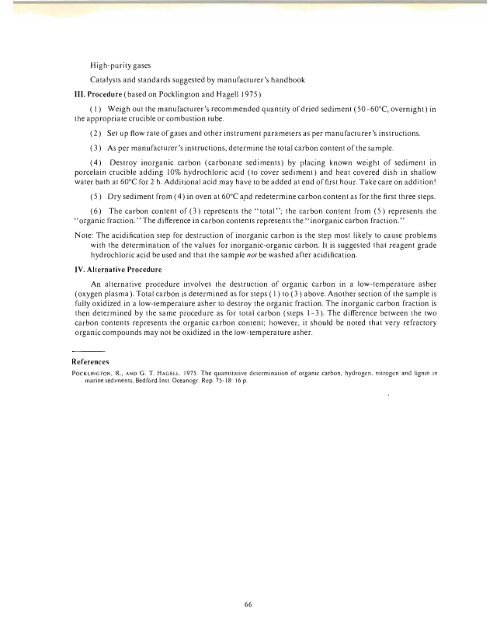You also want an ePaper? Increase the reach of your titles
YUMPU automatically turns print PDFs into web optimized ePapers that Google loves.
High-purity gases<br />
Catalysts and standards suggested by manufacturer's handbook<br />
III. Procedure (based on Pocklington and Hagell 1975)<br />
(I) Weigh out the manufacturer's recommended quantity of dried sediment (50-60°C, overnight) in<br />
the appropria te crucible or combustion tube.<br />
(2) Set up flow rate of gases and other instrument parameters as per manu facturer 's instructions.<br />
(3) As per manufacturer's instructions, determine the total carbon content of the sa mple.<br />
(4) Destroy inorganic carbon (carbonate sediments) by placing known weight of sediment in<br />
porcelain crucible adding 10% hydrochloric acid (to cover sediment) and heat covered dish in shallow<br />
water bath at 60°C for 2 h. Additional acid may have to be added at end offirst hour. Take care on addition'<br />
(5) Dry sediment from (4) in oven a t 60°C a,nd redetermine carbon con ten t as for the first three steps.<br />
(6) The carbon con tent of (3) represen ts the " total"; the carbon con ten t from (5) represents the<br />
"organic fraction." The difference in carbon contents represents the" inorganic carbon fraction."<br />
Note: The acidification step for destruction of inorganic carbon is the step most likely to cause problems<br />
with the determination of the values for inorganic-organic carbon. It is suggested that reagent grade<br />
hydrochloric acid be used and that the sample not be washed after acidification.<br />
IV. Alternative Procedure<br />
An alternative procedure involves the destruction of organic carbon in a low-temperature asher<br />
(oxygen plasma). Total carbon is determined as for steps ( I ) to (3) above. Another section of the sam pie is<br />
fully oxidized in a low-temperature asher to destroy the organic fraction. The inorganic carbon fraction is<br />
then determined by the same procedure as for total carbon (steps 1-3). The difference between the two<br />
carbon contents represents the organic carbon content; however, it should be noted that very refractory<br />
organic com pounds may not be oxidized in the low-tern pera ture asher.<br />
References<br />
POCKLINGTON. R .. AND G . T. HAG ELL. 1975. The quantitative determination or organic carbon. hydrogen. nitrogen and lignin in<br />
marine sediments. Bedrord Ins!. Oceanogr. Rep. 75·18: 16 p.<br />
66

















